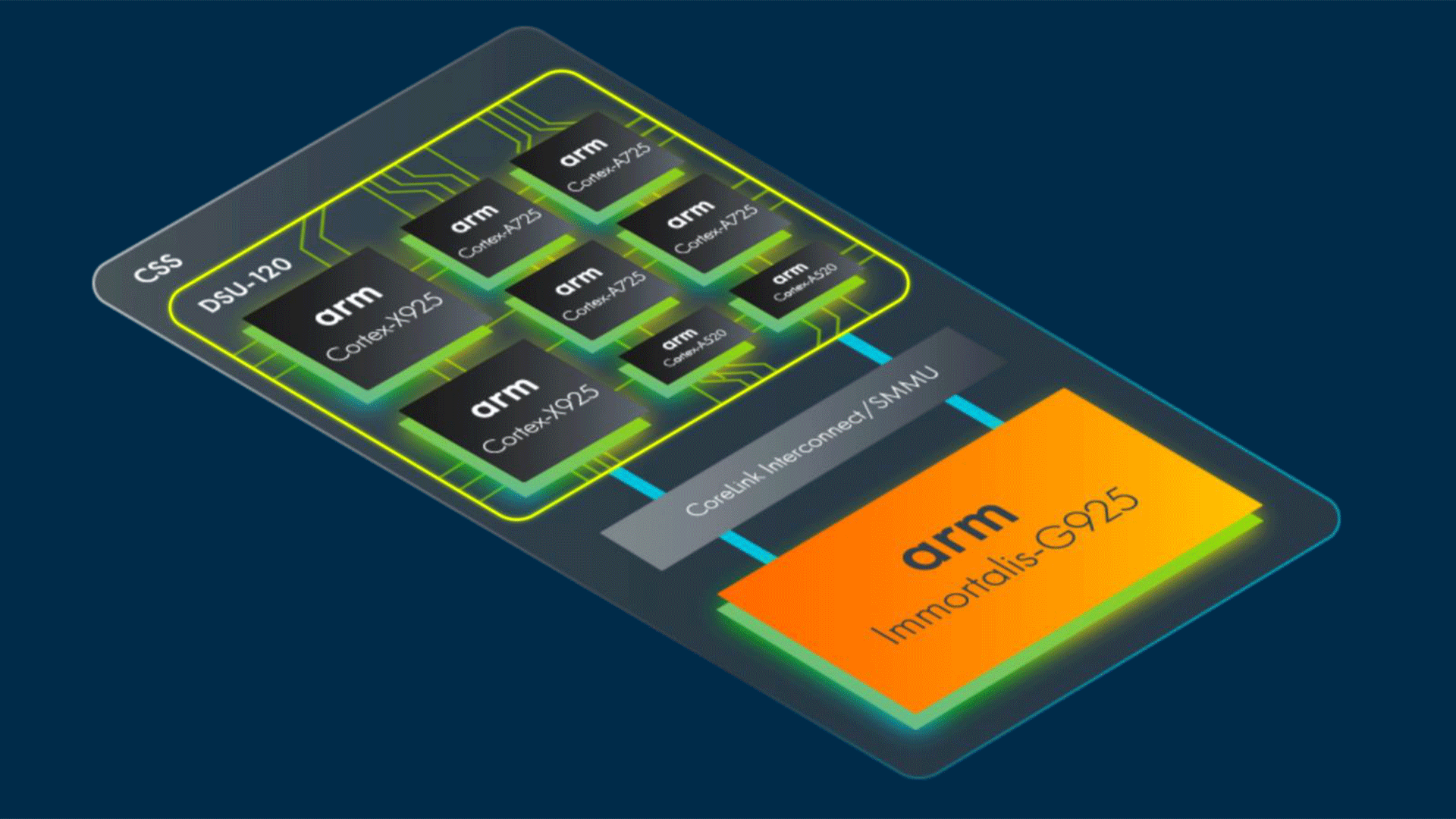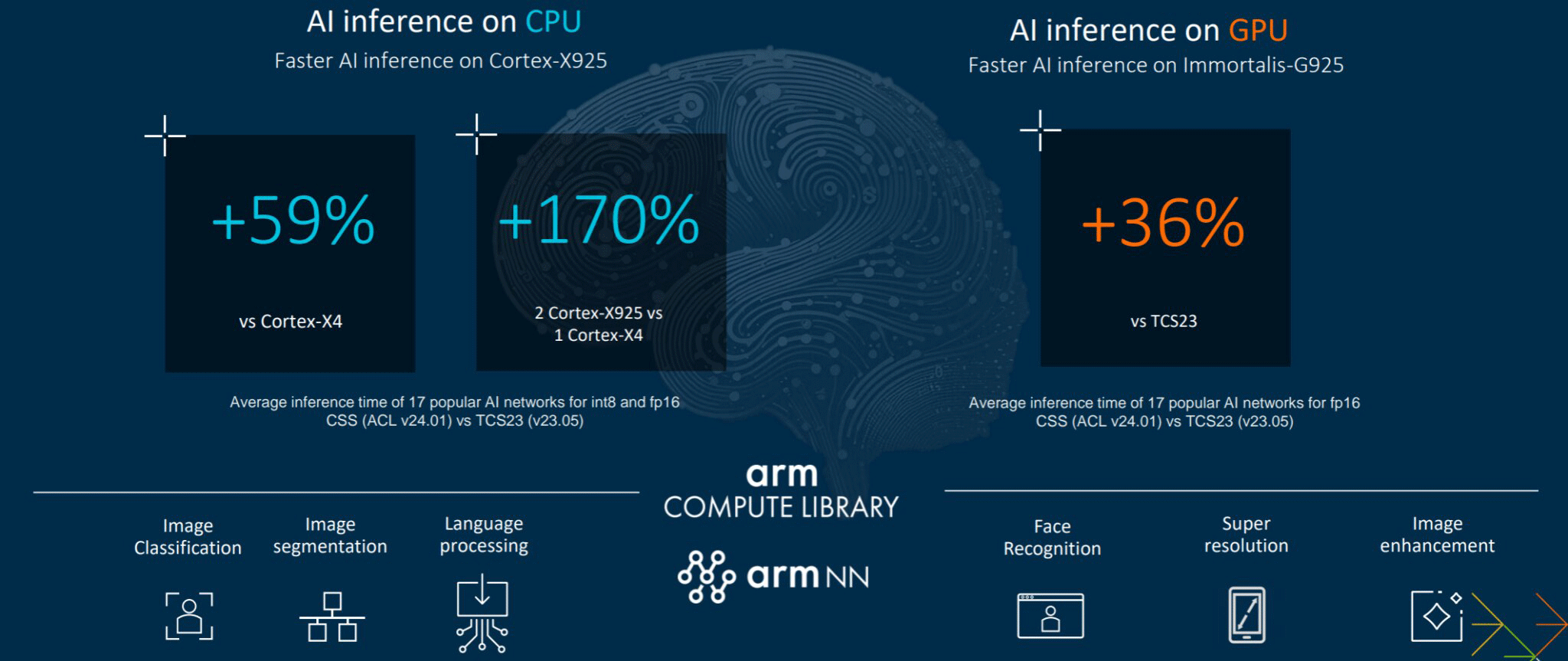Arm takes aim at client PCs with new 3nm compute subsystems, offering pieces of its IP to its customers for desktops, laptops, and tablets
Arm's new compute subsystems can enable PCs and tablets running Android, Linux, and Windows.

Arm on Wednesday introduced its first compute subsystems for client PCs, greatly simplifying the development of processors for desktops, laptops, and tablets running Android, Linux, and Windows. The new CSS packs high-performance CPU and GPU IPs and will enable Arm's partners to build high-end system-on-chips for mobile devices and therefore potentially greatly expand the Arm ecosystem.
"We are now delivering physical implementations across Arm, CPU and GPU, making it easier to build and deploy Arm-based solutions and leaving nothing to chance, enabling new performance points, compute capabilities, and helping speed time to market," said Chris Bergey, SVP & GM of Arm's Client Line of Business.
Arm's CSS for client PCs relies on two ultra-high-performance Arm Cortex-X925 general purpose cores (up to 3MB L2 cache per core and over 3.60 GHz clocks, SVE, SVE2 support), four high-performance Cortex-A725 cores, two energy-efficient Cortex-A520 cores, and an Immortalis-G925 graphics processor. Arm's latest CSS can support up to 14 CPU cores. The CSS is a production-ready physical implementation that can be made on a 3nm process technology (presumably TSMC's N3E — though this is speculation).
Actual specifications of Arm's CSS implementation could be altered by the processor vendor to meet its performance and power goals, but the FPGA that Arm used for performance evaluation included a Cortex-X925 core (2 MB L2, 3.80 GHz), 16MB L3, 32MB system level cache, DSU at 2 GHz, and LPDDR5X-8533 memory.
"Arm is providing more value, optimizing the whole stack for new 3nm process nodes, working with our leading foundry partners," Bergey said. "This allows us to provide IP in physical form. CSS for client brings together the physical implementation with the goodness of the Armv9 architecture for AI."
Arm says that its 2024 CSS for client PCs provides significantly higher performance than its TCS23 (total compute solution 2023) platform from last year, both in synthetic and real-world applications — at least based on FPGA performance runs.
The Cortex-X925 CPU achieves a 36% increase in peak performance, as shown by Geekbench 6 single core scores compared to TCS23, according to Arm. It also reduces application launch times by 33% on average across five of the top 10 apps, enhancing productivity and providing a smoother user experience on mobile devices. Additionally, it offers a 60% improvement in web browsing speed, according to the Speedometer 2.1 benchmark, and boosts peak graphics performance by 30% on average across seven graphics benchmarks, including ray tracing and variable rate shading (VRS).
Get Tom's Hardware's best news and in-depth reviews, straight to your inbox.


The new Cortex-X925 platform also offers up to 42% higher performance in LLaMA 3 (eight billion parameters) and up to 46% higher performance in Phi 3 (3.8 billion parameters) AI models compared to Cortex-X4, when using KleidiAI libraries designed to speed up AI applications on modern Arm CPUs.
Processors based on Arm's CSS will compete both against x86 processors from vendors like AMD and Intel and against SoCs from Qualcomm, which is about to roll out its Snapdragon Elite processors.

Anton Shilov is a contributing writer at Tom’s Hardware. Over the past couple of decades, he has covered everything from CPUs and GPUs to supercomputers and from modern process technologies and latest fab tools to high-tech industry trends.
-
bit_user The big question is who will be using this in SoCs for mass market laptops or mini-PCs? Mediatek? Rockchip? I guess we'll have to wait until Computex.Reply
I wonder if these new X cores can manage to narrow the gap between ARM's cores and Apple/Qualcomm. It seems the next couple years will be really interesting, in the CPU domain.
P.S. Somehow, I missed that they aligned their X-series naming with their A-series, but I'm actually glad they did. It saves me the trouble of having to keep a mental mapping. It does feel a little redundant to have the X9 prefix vs. just X, but it matches the A3, A5, and A7 prefixes they use further down the range. -
Lucky_SLS If this outperforms Qualcomm's Elite X chips in performance, ARM did them dirty with the launch window.Reply
Guess this is their best way of collecting royalties for their IP... -
DS426 Reply
Right!? Sometimes, having a timely lateness to the party can be a real winner. Still, I have to give Qualcomm props for taking the lead and big risk on their investment; this at least appears as though ARM is doing it as reactionary rather than already having planned it prior to Q's announcements.Lucky_SLS said:If this outperforms Qualcomm's Elite X chips in performance, ARM did them dirty with the launch window.
Guess this is their best way of collecting royalties for their IP...
Whatever the case, it's REALLY heating up in the Windows client CPU space, and I'm likin' it! AMD and Intel will be forced to compete even harder, so you bet I'm getting my popcorn ready. If Intel stays on track throughout this year and AMD delivers more on Zen 5 than what we're seeing in leaks and limited tested right now (recall that Zen 4 was mainly the platform change and not a huge architecture change from Zen 3 while Zen 5 was supposed to be a larger architecture i.e. perf uplift). -
DS426 Reply
Almost certainly yes on Mediatek and a fair possibility on Rockchip as well. I'd also be surprised if Broadcom didn't want a slice of the pie as well.bit_user said:The big question is who will be using this in SoCs for mass market laptops or mini-PCs? Mediatek? Rockchip? I guess we'll have to wait until Computex.
... -
Notton Okay, so how fast are the reference models they compared their new design against?Reply
Is it M1 fast, or A14 bionic fast? -
bit_user Reply
The second bar, "2023 Best-in-class", would seem to refer to whatever was the latest Apple core launched last year:Notton said:Okay, so how fast are the reference models they compared their new design against?
Is it M1 fast, or A14 bionic fast?
Source: https://fuse.wikichip.org/news/7761/arm-launches-next-gen-flagship-cortex-x925/
P.S. No love for ARM's infamous unitless graphs that apparently don't even start at zero, this time. -
Lucky_SLS I am guessing Samsung will bake the Exynos variant in their own fabs for their Galaxy book series.Reply -
dehjomz I wonder how these standard ARM 3nm chips will compare with Qualcomm Snapdragon X Elite? I also wonder if/when we will see these chips in a miniPC and/or a Raspberry Pi type of device. Like a Raspberry Pi Elite....Reply -
bit_user Reply
Well, if it did, it would mark a major shift in Raspberry Pi's product strategy. But, maybe the cash infusion from their upcoming IPO would afford them the opportunity to try it.dehjomz said:I also wonder if/when we will see these chips in a miniPC and/or a Raspberry Pi type of device. Like a Raspberry Pi Elite....
Thus far, Raspberry Pi has always used older ARM cores on an older manufacturing node, in the interest of keeping costs low. The Cortex-A76 cores in the Pi 5 first appeared in phones about 4 years earlier. By comparison, their main competitor, the Rockchip 3588 SoC, launched over a year earlier, on a better node, and with an additional 4x Cortex-A55 cluster, a NPU, and a faster Mali GPU. I have yet to hear of a successor, but maybe someone else has?
I saw some news that MediaTek launched a Cortex-A78 -based IoT chip last year, but I have yet to hear of any Pi-class devices using it. Perhaps it's too expensive.
https://www.cnx-software.com/2023/05/08/mediatek-genio-1200-linux-system-on-module-powers-cortex-a78-a55-aiot-development-kit/ -
thestryker While I'd like to see more CPU competition as that's what pushes innovation I don't really see these being a thing real soon. Qualcomm has a good number of design wins, especially the Surface line, which is great for the foothold and now it will just take more options hitting the market. Hopefully this will drive more of a middle ground in Arm CPUs where we get better overall connectivity than a phone SoC, but without the higher cost of something enterprise.Reply


